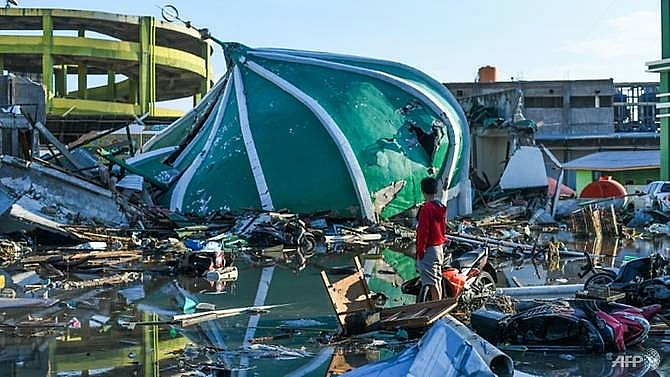Perfect storm of factors behind Indonesian quake-tsunami
 |
| Questions have mounted about what exactly happened and if more could have been done to save lives AFP/JEWEL SAMAD |
The massive 7.5-magnitude tremor struck Friday and sent monster waves barrelling into the island of Sulawesi, leaving at least 844 dead in the seaside city of Palu and surrounding areas.
As victims were buried in a mass grave and rescue teams struggled to reach remote areas, questions mounted about what exactly happened and if more could have been done to save lives.
The tragedy has highlighted what critics say is a patchy early-warning system to detect tsunamis in the seismically-active Southeast Asian archipelago.
"There was no information about a tsunami recorded by the tide-monitoring station in Palu because it was not working," Widjo Kongko, a tsunami expert with the Indonesian government's technology agency, said.
The station keeps a check on changes in tides and should have detected if destructive waves were headed for the city.
After the initial quake, Indonesia's geophysics agency - which monitors seismic activity - did issue a tsunami warning but lifted it soon afterwards.
It was only later that images emerged of a surging wall of water charging into the coast, flattening buildings and overturning cars.
Tide-monitoring stations and data-modelling are the main tools in Indonesia for predicting if a quake has generated a tsunami.
BESET BY PROBLEMS
But even if all the country's stations are working, experts say the network is limited and in any case gives people little time to flee as they only detect waves once they are close to shore.
Efforts to improve systems have been beset by problems, from a failure to properly maintain new equipment to bureaucratic bickering.
After a quake-tsunami in 2004 off Sumatra island killed 220,000 across the region, with most victims in Indonesia, 22 early-warning buoys were deployed around the country to detect tsunamis.
But officials have admitted that they are no longer working after being vandalised and due to a lack of funds for maintenance.
In another case, a major project with funding from the US National Science Foundation to deploy high-tech tsunami sensors in a quake-prone part of western Indonesia has been delayed.
Louise Comfort, a natural disaster expert from the University of Pittsburgh who has led the American side of the initiative, said that it had been put on hold after disagreement between government agencies and a delay in getting financing.
"It's so disheartening and it's so sad because we've got the technology, we've got the knowledge, we know we can do it," she said.
EDUCATION OVER TECHNOLOGY
However, others called for a stronger focus on simply teaching people to head to higher ground when a quake hits, rather than on expensive technology which many communities in a developing country like Indonesia cannot afford.
"For a place like Indonesia to try and defend its coastline, education is almost certainly going to outpace technology for the foreseeable future," said Adam Switzer, a tsunami expert from Nanyang Technological University's Earth Observatory of Singapore.
"Every kid in Indonesia needs to be taught what to do if they are on the coast and there is an earthquake."
Observers stressed the Indonesian quake was highly complex, and it would not have been easy to predict it would send a tsunami barrelling towards the small community of Palu.
The initial tremor was a sideways movement of tectonic plates, rather than the sort of violent upward thrust that would typically generate destructive waves, and was followed by scores of aftershocks.
Experts believe that the tsunami could have been triggered by an underwater landslide that followed the tremor.
Palu's unique geography will not have helped, they said - the tsunami likely intensified as it raced down the narrow bay on which the city sits.
"Geographical factors (the narrow bay, shallow water) seemed to have played major roles," said Taro Arikawa, a professor at Chuo University in Tokyo.
"The tsunami must have come very fast and suddenly."
What the stars mean:
★ Poor ★ ★ Promising ★★★ Good ★★★★ Very good ★★★★★ Exceptional
Related Contents
Latest News
More News
- 72 nations sign landmark Hanoi cybercrime convention (October 26, 2025 | 18:00)
- UN Secretary-General commends Vietnam’s global leadership (October 26, 2025 | 09:00)
- APEC finance ministers convene to tackle regional challenges (October 22, 2025 | 17:31)
- Rewiring global trade: ASEAN’s rise as supply chain hub (October 17, 2025 | 11:40)
- Vietnam attends first World Nuclear Week Forum in Russia (September 26, 2025 | 10:50)
- Vietnam attends 69th session of IAEA General Conference (September 16, 2025 | 10:00)
- ADB, WB pledge over 12 billion USD for ASEAN power grid, renewable energy projects (August 15, 2025 | 14:18)
- Lowy Institute proposes AI-based tobacco control solutions for ASEAN (August 15, 2025 | 14:14)
- Cloud computing policy to position Malaysia as regional hub by 2030 (August 15, 2025 | 14:11)
- Thailand, Cambodia suffer numerous cyber attacks (August 05, 2025 | 16:19)

 Tag:
Tag:





















 Mobile Version
Mobile Version